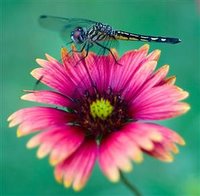Dragonfly Migration

Simple rules guide dragonfly migration
(by Martin Wikelski, David Moskowitz, James S. Adelman, Jim Cochran, David S. Wilcove, Michael L. May)
Biology Letters 10.1098/rsbl.2006.0487 (9 May 2006)
ABSTRACT: Every year billions of butterflies, dragonflies, moths and other insects migrate across continents, and considerable progress has been made in understanding population-level migratory phenomena. However, little is known about destinations and strategies of individual insects. We attached miniaturized radio transmitters (ca 300mg) to the thoraxes of 14 individual dragonflies (common green darners, Anax junius) and followed them during their autumn migration for up to 12 days, using receiver-equipped Cessna airplanes and ground teams. Green darners exhibited distinct stopover and migration days. On average, they migrated every 2.9±0.3 days, and their average net advance was 58±11km in 6.1±0.9 days (11.9±2.8kmd−1) in a generally southward direction (186±52°). They migrated exclusively during the daytime, when wind speeds were less than 25kmh−1, regardless of wind direction, but only after two nights of successively lower temperatures (decrease of 2.1±0.6°C in minimum temperature). The migratory patterns and apparent decision rules of green darners are strikingly similar to those proposed for songbirds, and may represent a general migration strategy for long-distance migration of organisms with high self-propelled flight speeds.
In the article below, Corey Binns addresses the recent article published in Biology Letters about how scientists have found that the bugs follow the same migratory patterns that birds do.
Dragonflies migrate just like birds
(MSNBC, 15 May 2006)
Small animals have been migrating since ancient times, but scientists still don't know very much about where most of the wandering critters come from or where they're going. "We're just about as ignorant as Aristotle was 2,000 years ago," said biologist Martin Wikelski, referring to the Greek philosopher's false claim that birds hibernated in marshes during winter. Wikelski knows more than Aristotle now, at least on one topic.
In a recent study, he led a team of Princeton researchers who found dragonflies and songbirds share long-distance travel habits, suggesting migration behaviors are less complex and could be more than 100 million years older than previously thought.
The scientists stuck tiny radio transmitters to the wings of 14 green darner dragonflies and followed the radio signals in an airplane and with handheld devices on the ground.
"They migrate exactly like birds—or birds actually migrate like insects," Wikelski told LiveScience.
Although dragonflies are 140 million years older than birds, according to fossil records, they abide by the same temperature and wind rules. Both groups stay put on blustery days and travel only after two days of cooling temperatures. They even use the same markers on the landscape, and rest on the same beaches.
"We saw other similarities as well, which makes us wonder just how far back in Earth's history the rules for migration were established in its animals," said Wikelski. Radio transmitters attached to flying, migrating insects and birds can tell researchers a lot about how small animals travel. Wikelski is now using the technology to study bat migration.
Hooked up to satellites, the transmitters could track small animals on a global scale. The information would help scientists make plans for conservation, predict locust swarms, and protect people from introduced species and diseases.
"We need to spend some time observing animals on this planet," said Wikelski. "This importance has been brought home with avian flu. We don't know where it comes from or where it's going."
Photo credit: Phil Sandlin/AP file

0 Comments:
Post a Comment
<< Home